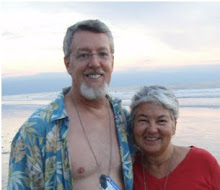
While the boat was in the yard, we decided to visit the city of Guadalajara. For about $40 each, we bought tickets on a very comfortable bus for the seven hour trip. We stayed four nights at the San Francisco Plaza Hotel, in an old colonial building in the Centro Historico--the city center. Here is a picture of Claudia having breakfast in one of the interior courtyards for this nice, old hotel. It was not luxurious, but it certainly had character and a sense of history.

Here is the stairway up to our room.

And here is the outside of the hotel, which is on a small square about a block from San Francisco Plaza.

We spent two days looking at the architecture and public art in the city center, and visiting museums there. The Centro Historico is beautiful.



Much of the art made reference to events in the history of Mexico. We found ourselves wishing knew more of this history so that we could understand the art better. There are major murals by Jose Orozco, and one of the museums has an extensive exhibit that documents Orozco's entire career as an artist. Orozco's art is highly political and his huge figures are very impressive on the walls of the old buildings. Orozco seemed to make a point of criticizing his patrons. He painted murals with anti-religious themes (such as images of Christ cutting down his cross) on churches; images of legal corruption and bribery on the walls of appellate courts; images demonizing governmental power and glorifying insurgency on government buildings; and so on. It is disconcerting, although certainly interesting. Here are some of Orozco's images from the Governor's Palace.



 We also spent a day in the nearby town of Tlaquepaque, which is a well-known center for arts and crafts, particularly ceramic pottery, as well as mariachi music. Here are some Tlaquepictures:
We also spent a day in the nearby town of Tlaquepaque, which is a well-known center for arts and crafts, particularly ceramic pottery, as well as mariachi music. Here are some Tlaquepictures:

Another highlight of the trip was a visit to the central mercado, a huge building full of tiny shops. It was a giant warren crammed full of merchandise. One area had dozens of tiny restaurants. Birren (goat) is a local specialty.


We returned to Mazatlan on Monday, March 29, and discovered that progress on the boat had been slow. We have moved back aboard the boat, but it is still "on the hard" (as yachtistas say). To board the boat, we must climb a ladder. Work has been slow because this is Semana Santa (Easter week), which is honored here with much loud revelry and partying. The population of Mazatlan has more than doubled as Mexicans from inland areas have flocked to the beach. More on the boat project, and Easter celebrations later...


















